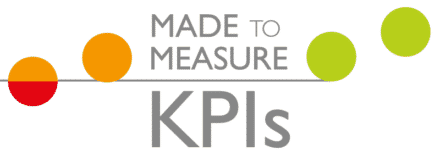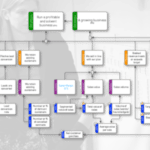OKR Definition
Let's start with the basics. OKR stands for Objectives and Key Results. Essentially, OKRs are a framework for setting goals that are clear and measurable. This makes the goals easier to track and measure progress towards. When done well, the OKR framework helps create a culture of accountability and engagement.
OKRs originated at Intel in the 1970s under then-CEO, Andy Grove, were spread through Silicon Valley by John Doerr, popularised by Google, and now are widely-used in tech and other industries to align organisations on strategic goals.
Although the approach can seem simple and logical, setting effective OKRs can be tough. This complete guide to the OKR framework aims to give you a solid understanding of the OKR and all the basics around them, plus it aims to teach you exactly how to create OKRs that will drive growth by following a robust approach. Our 10 step system will make implementation of the OKR framework easy, warning you about common OKR mistakes and giving you plenty of good examples to learn from.
OKRs vs KPIs - What's the Difference?
OKRs are not to be confused with KPIs, which stands for key performance indicators. The main difference is that OKRs help set goals and plan how to track them, while KPIs are the actual measurements used to see if the goals are being met.
To illustrate, Imagine I'm a smoker and I'm trying to quit. My objective might be to “Give up smoking cigarettes forever”.
A key result that will help me achieve that might be “To not smoke a cigarette for seven days".
My KPI for that period would be "Number of cigarettes smoked" with a KPI target of zero cigarettes.
Key Performance Indicators are simply the facts of the situation. Targets, Key Results and Objectives help give those facts context and generate motivation.

The Benefits of the OKR Framework
Good OKRs provide a clear direction for an organisation. Once you are up and running, you should find multiple benefits, including...
- Simple to explain: Although designing effective OKRs is more complex that it might appear, they are quick and easy to explain and understand once created.
- Build commitment and motivation: With everyone in the team being clear on what personal success looks like, OKRs nurture engagement and clarity.
- Focused and aligned goals: When done right, they ensure that all activity contributes toward the ultimate goals, objectives and strategy of the organisation (everyone pulls in the same direction).
- Simple to monitor and review: OKRs are quick and simple to review compared with other goal management frameworks.
- Flexible and adaptable: They can be used by teams of all sizes and in a variety of industries. This makes them a versatile goal-setting tool that can be applied in a wide range of situations.
- Support a culture of accountability: By setting specific, measurable goals, you can hold your team accountable for making progress towards those goals. This can help create a sense of ownership and responsibility, which can lead to better results and a more engaged team.
- Encourage stretch: Unlike 'business as usual' monitoring of KPIs, OKRs need to be ambitious, with a serious chance of failure. A culture that encourages ambition will help accelerate performance and progress.
Components of the OKR Framework
The 'OKR formula' is:
- Objectives: These are the high-level goals that the organisation is working towards. Objectives should be specific, measurable, ambitious, and aligned with the overall goals and strategy of the organisation.
- Key Results: These are specific, measurable outcomes, task or actions that help the organisation progress towards achieving its objectives. They should be linked directly to the corresponding objective, and they should be designed to be specific, measurable (or tangible, in the case of tasks and actions), and time-bound. Typically, you will have two to five Key Results per Objective. Where you have a numerical result reported by a KPI you will also have...
-
- Key Result Targets: These are the specific, measurable targets that the organisation is working towards for each key result. Targets should be set to be challenging, but achievable, and they should be aligned with their overall Objective and Key Results.
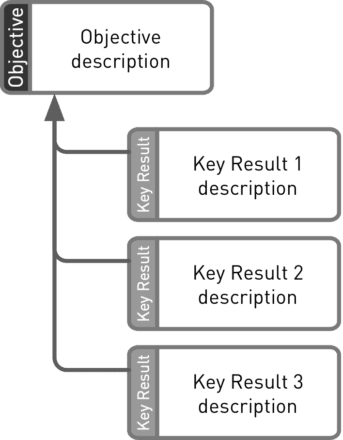
Characteristics of a Good OKR
Good OKRs should be...
- Aligned with company strategy: OKRs should be aligned with the overall strategy and goals of the organisation.
- Specific and measurable: Key results must always be specific and measurable (even if it's just a 'Yes, we have done that'), so that progress can be tracked and evaluated. Objectives themselves do not always have to be directly measurable, but must be a clear outcome of the (measurable) key result(s).
- Challenging (a stretch): OKRs should be tough to achieve. As a rule of thumb, you should not expect people and teams to achieve all of their planned OKRs. If they do, chances are the the agreed OKRs are not challenging enough.
- Actionable: There should be clear steps that can be taken to achieve the objective.
- Transparent: Everyone in the organisation should know what is expected of them and how they can contribute.
- Reviewed regularly: This is to ensure that progress is being made and to make any necessary adjustments.
OKRs vs SMART Goals: Why SMART Goal Setting is Not Enough for Designing OKRs
Of all the guides on the OKR methodology, 99% of them will start talking about SMART goals. In case you have been living under a rock for the last 20 years, here are the criteria for a SMART goal, target or task...
- Specific
- Measurable
- Achievable
- Realistic
- Targeted/Time-bound
The trouble is, SMART is only part of the picture. It is perfectly possible to have objectives and key results which are SMART and still fail.
Why is this? Well, here are some common issues that SMART goal setting, targets and objectives do not address...

8 Common SMART OKR Design Problems
SMART objectives have several benefits, but also some potentially fatal flaws and gaps. Here are some of the most serious risks that come from using just the SMART approach for OKR design...
1. Lack of ambitious goals:
Kaizen (a Japanese business philosophy) and continuous improvement have proven that cumulative small wins can be important, but stretch goals are critical too. Without ambition, OKRs become 'just another management admin task' and quickly fall out of use.
2. Lack of alignment with organisational objectives:
It's fairly straightforward to pluck objectives and key results out of thin air in isolation. The real challenge is to make sure they all line up with the overall company objectives. Every key result and objective must ultimately lead to delivery of one or more of our corporate objectives. If that’s not the case, then our effort is wasted or our strategy is poorly defined.
3. Targeting a single metric, KPI or measure:
Targeting just one metric can be a highly risky business. If you take the example of a contact centre, only targeting ‘average handling time’ (AHT) can lead to dangerously rapid call handling, persistent unresolved problems and unhappy customers. We need to have a basket of metrics to ensure that we don't drive extreme and counterproductive behaviours within our team.
4. Poor engagement of the team and stakeholders:
It's one thing to create OKRs, it's another to build proper stakeholder engagement. Lack of engagement is one of the biggest risks to any form of performance management system, be it OKRs, Balanced Scorecard or any other approach. Our design system needs to include a structured and systematic approach for early, well-considered stakeholder communication and engagement.
5. Lack of owner agency:
If you took an average middle-aged guy and offered him $100m to jump 3 metres (9 feet) in the high jump, it doesn’t matter how much reward you offered him, he’s either going to cheat or kill himself trying. Success is highly unlikely. He does not have the agency to achieve the objective you are setting.
It’s very important that we consider four ingredients of agency when we set our Key Result KPI targets. These ingredients are…
-
- Skills
- Time
- Authority
- Resources
…or STAR, for short. SMART arguably covers this to some extent in the 'Realistic' element of the acronym, but the STAR approach helps us review each element specifically.
6. Arbitrary target and key result values:
If we don’t understand how we performed in the past, what ‘best possible’ performance looks like and how practical it is to achieve an outcome, our targets are likely to be arbitrary and potentially unachievable. Historical data and best-observed performance, gives us a fact-based foundation for our key results design, and a powerful argument for their validity.
7. Gaming the system (cheating):
As anyone who has played family board games knows, humans are optimisation machines and often rampantly cheat if they think they can get away with it. People will attempt to achieve the objectives and key results by any means necessary and this often includes gaming the system and rules. Understanding that this happens and that it is predictable and preventable is essential. We need to include steps in our OKR design method to anticipate the nature and intensity of this cheating, and to mitigate it. We have a whole system which is designed to set targets and incentives that can't be gamed - check it out here.
8. Poor maintenance:
Even the best designed OKRs will fail if they are not regularly reviewed, discussed and tuned. Simply creating OKRs is not enough, they need to become part of the 'management control system'. This may sound complex, but in practice it means regular, structured, review sessions with the right people and solid action-management that delivers results.
How to Create OKRs in 10 Logical Steps
Effective OKRs can have a significant impact on the business which is why we have created a roadmap that exact steps on how to create OKRs. This powerful OKR process is called OKR-DS, and it is designed to take the guesswork out of OKR design. Combine this with KPI selection and you'll avoid common pitfalls.
Here's an overview of it's 10 steps followed by a closer look at each individual step...
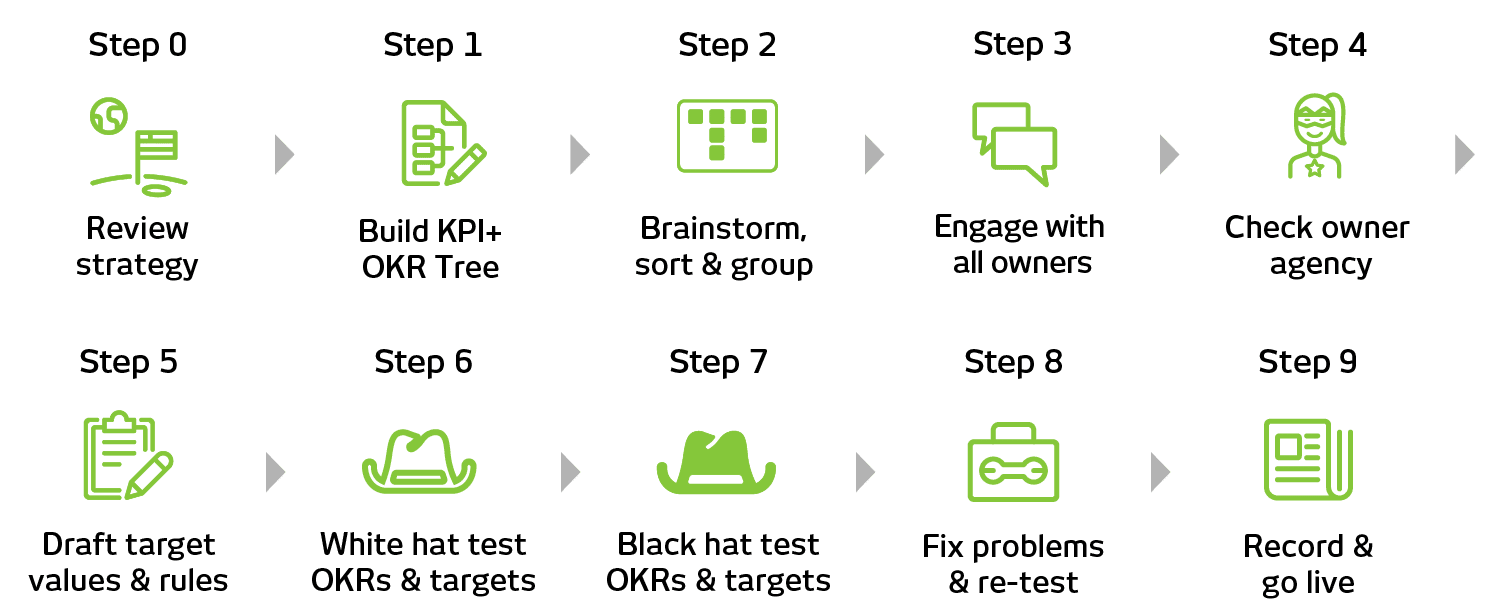
The OKR-DS 10 Step Method
Step 0: Review
Picking the right objectives is essential. We need to identify or revisit the high-level outcomes that we're looking for. This will involve a review of the existing strategic documentation and possibly the creation of new strategy statements. Head to this post on how to choose strategic objectives for some practical help.
Step 1: Build KPI + OKR Tree
Build your KPI Tree. For much more detail on how to do this, head to How to build powerful KPI Trees. At this stage it is just an KPI Tree, we will add the OKR element in the next step.
Step 2: Brainstorm sort and group
Pull together your core stakeholder group for the brainstorming session. The exact mix of the group will depend on you particular situation, but it can help to include a variety of stakeholders as they will bring different perspectives.
If you are in a meeting room together, unroll a wide-format printout of your KPI Tree. If you are online, use a virtual whiteboard tool (like Miro or Mural).
On your KPI Tree, mark the boxes that will offer a significant boost to the business.
Brainstorm the critical outcomes, results, activities and tasks that will have a positive effect on the KPI Tree boxes you flagged as important.
Run through the stickies (or virtual stickies) and sort them into 'Objectives' or 'Key Results'. Some may fall into both categories, as they are linked and aligned. In that case make as many copies as needed.
Sort and group the Objectives and Key Results into specific draft OKRs. Don't worry about getting the specific target values perfect at this stage, we will revisit them in Step 5.
Add these draft OKRs to your KPI Tree. Use the tree to identify the relevant and related KPIs that will show you if you’re on track for achieving the high-level goal from Step 1 and draft OKRs from this step. KPI Trees are a rich and powerful way of understanding the links between performance and outcome, but they do take time and effort. To find out more about KPI Trees head to our full guide - 'How to build KPI Trees'.
Step 3: Engage with all OKR owners
In this step we identify everyone who can influence the Objectives and Key Results we identified in the previous step. Share the KPI + OKR Tree, invite feedback and input.
For larger organizations a communications plan can also be a good idea.
Use RACI and stakeholder trackers to manage that process.
Step 4: Check Owner Agency
Review the draft OKRs and relevant KPIs to see if the target owners have the necessary agency. Agency is the ability to deliver the target result and includes...
Skills
Time
Authority
Resources
... or STAR for short. If your target owners don't have agency, it needs to be fixed. Setting OKRs for people and teams who don't have full agency is dangerous as it often leads to burnout, rule breaking, and even law breaking.
Step 5: Set Draft Key Result Target Values
Next you draft your initial values and rules for your targets. We need to decide whether we're going to use ‘all or nothing’ targets or perhaps tiered targets where we have different levels. Use historic data wherever possible when you're setting your draft targets; it gives a starting point for assessing what is achievable. Stretch targets work best if there's a bit of science behind them.
Step 6: White Hat Testing
In Step 6, you walk through what should happen if the OKR owners follow the process in the expected way, with no attempt to game or test the target rule set. This is normally a low-drama activity to make sure we have covered everything. Step 7 is where it starts to get interesting...
Step 7: Black Hat Testing
In ‘Black hat testing’ you get a little evil and ask, “In the real world, if we had to achieve these OKRs by any means necessary, how would we do that?” Use reverse brainstorming and to help flush out potential problems and solutions.
Step 8: Fix Problems and Re-test
Once you've identified potential problems using black hat testing, you need to skip back either to Step 2 (Brainstorm, sort and group) or to Step 5 (Set Draft Key Result Target Values), depending on whether you need additional KPIs or to rework KPI targets. Then, work through the subsequent steps in the process until you arrive back at 'Black hat testing'.
If you clear black hat testing with no issues, you are ready to head to our next step — Step 9: Record and Share OKRs.
Step 9: Record and Share OKRs
Once you've tested and tweaked your OKRs, targets and KPIs, you've got your final OKRs and target values and they get through black hat testing unscathed, it's time to record them in an accessible place, to share them, and to manage any post-launch updates and adjustments in a secure and transparent way.
When you come to build your OKRs, I’d recommend printing out the canvas (A2 works really well) and then put them on the wall. The team can write on it, add stickies, and use it as a focal point for workshops. The canvas will also guide you through the questions you need to ask in order to get good quality, effective, robust OKRs.
8 Tips for Setting OKRs for the First Time
- Always keep an eye on your business goals (better still, use a KPI Tree).
- Focus on creating alignment across all of your OKRs using OKR + KPI Trees.
- Setting OKRs for teams will encourage cooperation, as long as the OKRs across multiple teams are aligned properly.
- Write your OKRs down and review them regularly.
- Make sure your OKRs include stretch goals to challenge the status quo.
- Create OKRs that people agree on and feel passionate about.
- Use a mixture of behavioural and process key results to drive progress.
- Make OKRs become part of day-to-day work, not a 'special project'.
Remember, great OKRs are not just ones that look amazing, they must be used and challenged on a daily basis to effect real change. Your objectives and key results should not be a 'special project' but should rather become part of the day-to-day work, using an OKR cycle like this...
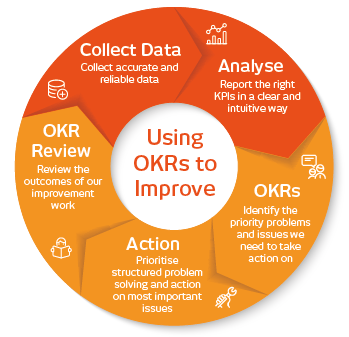
20 Great OKR Examples
Using the OKR methodology, we've outlined 20 illustrations of aspirational objectives and measurable results across various industries and team functions. Use these to sharpen your understanding of what good OKRs look like and then use our OKR-DS system to set and track your own.
Customer Service
- Objective: Deliver an awesome customer experience
Objective KPI and target: Increase customer satisfaction score by 11% by end of year.
Key results:
Implement a c-sat survey and track the results to identify areas for improvement.
Reduce our support ticket response time by 38%, which translates to us responding to support tickets within 12 mins 53 seconds time or less.
Increase our first-touch resolution rate to 78% or better.
- Objective: Reduce customer churn and improve customer retention by 5% in Q3.
Key results:
Implement a customer success program to proactively reach out to at-risk customers.
Achieve 100% completion rate on customer health-check calls by the end of this quarter.
Implement a customer loyalty program to reward and retain long-term customers.
Sales Team
- Objective: Increase revenue by 20% in Q3.
Key results:
Increase the number of qualified leads by 30%.
Increase the close rate on qualified leads by 10%.
Increase the average deal size by 15%.
Admin
- Objective: Improve document management system efficiency.
Key result:
Design, agree and sign off on a document catalogue structure.
Complete migration of all existing documents to the new system
Achieve a 0.2% or lower retrieval fail rate on the new system.
- Objective: Improve communication and collaboration within the team.
Key result:
Implement Microsoft Teams for all users.
Train 100% of the team in optimal use of Teams, Outlook and live meetings.
Create 1 page agendas for all formal meetings.
Marketing Team
- Objective: Increase brand awareness score by 22% by November.
Key result:
Launch a multichannel social media campaign targeting our customer demographic.
Increase the number of blog posts published per month by 20 per month.
Partner with 5 industry influencers to promote the brand.
Maintain marketing spend at or below last year's level.
- Objective: Increase website traffic by 250% in the first half of 2024.
Key result:
Complete on-page optimisation of our top 40 site pages, score over 80 for each.
Increase the number of inbound links, with a DR of 40+, to our main website by 20%.
Achieve 'good' core web vitals on Google Search Console.
Design Team
- Objective: Win a Red Dot design award for our Crevice Cleaner.
Key result:
Enter our Crevice Cleaner design in to the next Red Dot award.
Gain 5 or more positive industry magazine reviews.
Achieve product placement in Top Gear and Fifth gear TV shows.
- Objective: Increase design team productivity by 15% in H2.
Key result:
Produce 3 extra prototypes rated 'good' in blind testing.
Hire two new admin staff for non-design admin tasks.
Commission titanium 3D printer for prototyping.
Product Marketing Team
- Objective: Launch our Car Karaoke product successfully in February.
Key result:
Develop a comprehensive launch plan and timeline.
Set up weekly cross-function team timeline reviews.
Execute a dummy launch two months before the real thing.
- Objective: Increase product Car Crevice Cleaner refill purchases by 30% in Q2.
Key result:
Reduce current fill levels by 10%.
Include 50% capacity 'starter' cartridges in new Car Crevice units.
Develop point-of-sale material explaining the better value of the new formulation.
Digital Marketing
- Objective: Increase social media engagement by 23% in Q3.
Key result:
Implement a new social media content calendar.
Increase the frequency of social media posts by 57%.
Increase the number of user-generated content posts by 28%.
Human Resources
- Objective: Increase employee satisfaction score and retention by 10% in Q3.
Key result:
Implement a weekly team member satisfaction survey and track the results to identify areas for improvement.
Increase the average weekly employee satisfaction score by 5%.
Reduce employee turnover (team member turnover) by 8%.
- Objective: Reduce the application-to-start hiring process by 75% by July.
Key result:
Build role templates for all roles, for rapid advertising.
Introduce AI-assisted CV screening to reduce sift process to 1 hour or less.
Set up a SMED (cycle time reduction) team with the HR specialists.
Finance Team
- Objective: Improve financial forecasting accuracy by 18% or more in Q4, in line with our company goals.
Key result:
Implement a new financial forecasting tool and train all team members on its use.
Increase the number of data points used in financial forecasting by 44%.
Increase the frequency of financial forecasting updates from quarterly to monthly.
- Objective: Reduce expenses by 10% in May.
Key result:
Introduce our newly agreed approval limits.
Travel freeze, except when approved in writing by a Band 2 or above.
Renegotiate our comms contracts, with a target cost reduction of 30% or greater.
IT Team
- Objective: Reduce EPOS terminal downtime to 0.01% or lower next year.
Key result:
Roll out planned motherboard replacement (QZ7s with ceramic capacitors).
Procure and install uninterruptable power supplies for all EPOS terminals.
Implement failover backend site servers.
- Objective: Increase the speed of critical system patches (severity 7 or above) to 12 hours or less in Q3.
Key result:
Set up 24 hour central systems operational control room.
Commission Xod automated patch deployment platform.
Track emergency patch actions activity in ops activity tracker.
Project Management
- Objective: Increase the success rate of projects by 20% in H1.
Key result:
Implement weekly project health review meeting.
Identify key learning points from 5 biggest project failures last year.
Implement project failure key learning points and track impact on project success.
Product Management
- Objective: Launch a new product successfully in Q3.
Key result:
Develop a comprehensive product roadmap and timeline.
Collaborate with cross-functional teams to ensure a smooth product launch.
Achieve a 50% conversion rate from product demonstrations to sales.
- Objective: Increase product usage by 20% in Q3.
Key result:
Conduct user research to gather feedback on product features and usage.
Implement changes to the product based on user feedback.
Increase the number of active users by 25%.
Engineering Team
- Objective: Increase productivity of engineering processes by 25% in Q3.
Key result:
Identify and prioritise bottlenecks in the engineering process.
Implement new CAD/CAM suite to streamline the engineering process.
Measure and track the results of process improvements to ensure that efficiency targets are met.
Net Promoter Score (NPS)
- Objective: Increase NPS by 10% points in Q1.
Key Result:
Conduct customer surveys to gather feedback on the company's products and services.
Identify 3 priority areas for improvement based on customer feedback.
Implement changes to improve customer satisfaction and increase NPS.
Employee Engagement
- Objective: Increase employee engagement by 20% by Q3.
Key result:
Conduct a survey to gather feedback on employee engagement and identify areas for improvement.
Implement employee engagement initiatives, such as team building activities, leadership development programs, and recognition programs.
Track and measure the results of employee engagement initiatives to ensure that they are effective.
ESG: GHG Emissions and Diversity
- Objective: We reduce our calculated carbon dioxide emissions to the bottom decile for our industry (24 000 tonnes or lower, per annum).
Key result:
Switch our heating to ground source heat pumps powered by green electricity by June 1st.
Migrate half of our fleet to electric vehicles powered by green electricity by end of year.
Offset 90% of our remaining green house gas emissions by the end of next year.
- Objective: Deliver a truly diverse team.
Key result:
Increase women in senior leadership roles (bands 1 and 2) to 48% or greater.
Complete unconscious bias training for 100% of candidate facing team members.
Increase our recruitment of designated 'under represented groups' to 60% more than our April 2023 level.
Organic Website Traffic
- Objective: Increase organic traffic by 8x within 12 months.
KPI: Organic page hits.
Target: 10 048 or more hits per day, 7 day average.
Key result:
Produce one new optimised cornerstone blog post per week for whole of 2024.
Complete each Surfer SEO optimisation action plan for the whole of this year.
Design and roll out a new landing page implementing the CX report of Dec 2023.
Achieve 'Good' web vitals on Google Web console for site XYZ.com.

OKR FAQs
A Key Performance Indicator (KPI) is a numerical measure of some aspect of performance. A KPI simply shows the magnitude of something relevant to your organisation.
In contrast, an OKR is a goal-setting framework and consists of a combination of...
Objective - something you want to happen in order to deliver your strategy, and...
Key results - actions, tasks, outcomes or results that will help deliver the Objective.
This is where KPIs and OKRs work well together. A key result can have a KPI and target value associated with it, unless it is an action or task. The KPI element of the mix gives us objective answers to the question 'How are we doing in progressing towards our key results and company objectives?'
If we don't measure success once we have set OKRs, it's all pretty pointless. Fortunately, it doesn't have to be very complicated. As a minimum, you can have a simple spreadsheet which shows...
Objectives
Key result(s)
KPIs and targets
A column for each KPI result per period
Team OKRs are owned by two or more people. At the top level, company OKRs are really team OKRs for the entire organisation. Creating team OKRs where everyone is doing the same job is quite straightforward.
Where it starts to get tricky is where you have different roles within a team to contribute towards the same ultimate outcome. This is where we need to use a KPI Tree to allow us to assign measures to the various micro, midi and macro results that contribute towards a company's objectives.
Using a KPI Tree gives us a powerful visual tool for building the alignment that we need for team OKRs. Some elements of the team OKR may be common, but a specific key result may be unique to an individual or a subset of that team.
Absolutely! Shown below is an example of how you can integrate OKRs into a KPI Tree. It's not advised for beginners to try this straight after learning the KPI Tree approach, but once you've mastered KPI Trees, then it's a fantastic way of aligning objectives, targets and measures in one single, easy-to-understand document.
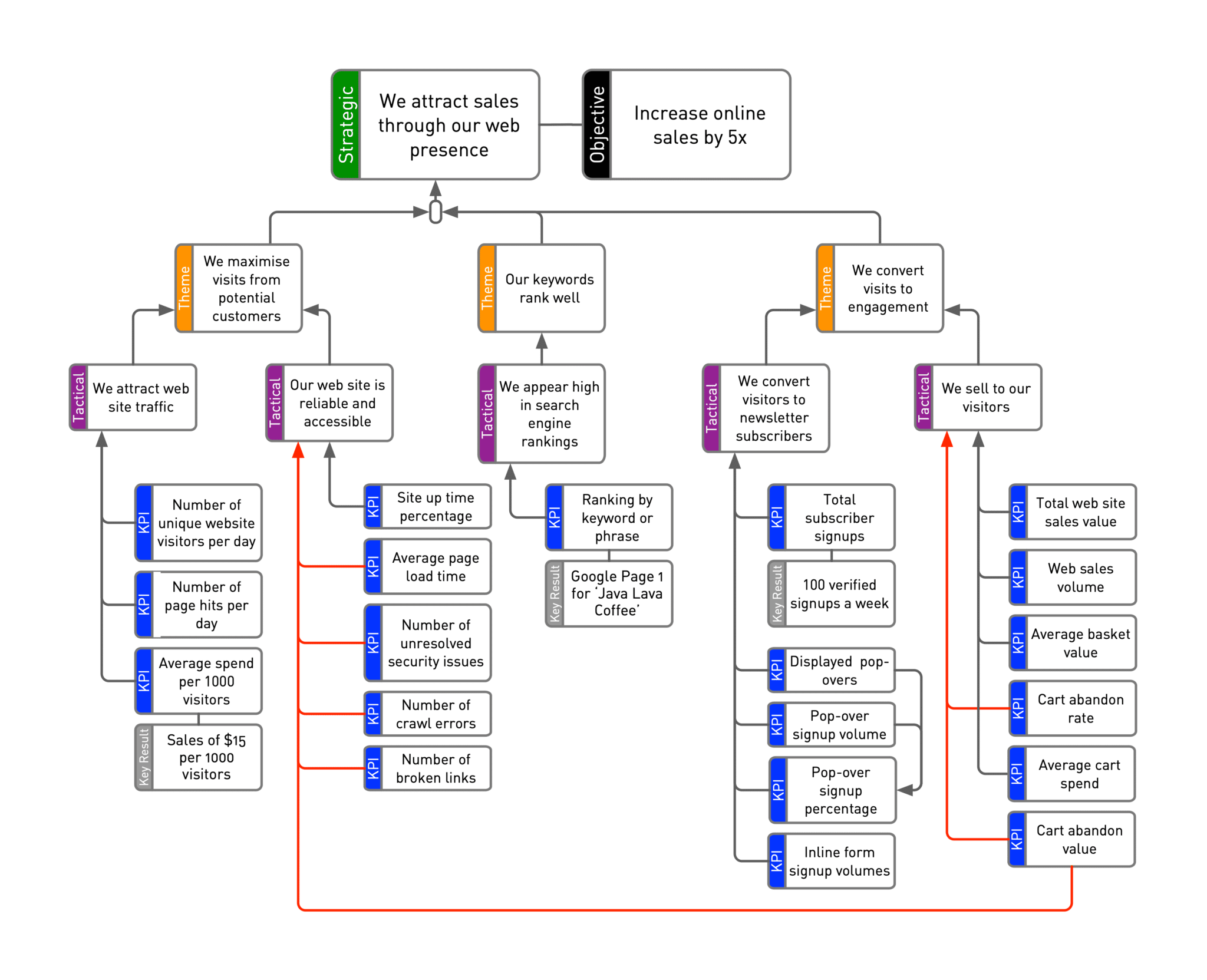
There's a real risk of going a bit 'over the top' when it comes to setting OKRs. Unless you are very experienced and have a clear reason for doing so, you should aim for a maximum of five committed OKRs per person. Each OKR should have three to five key results. When starting out with OKRs, it is a good idea to start with three or fewer objectives.
Generally, organisations use a mixture of both team and individual OKRs. It's important that an OKR is relevant to an individual to build motivation and commitment but also aligned with the organisation's OKRs. Team OKRs also have a place where you have a group working towards a common team outcome, for example in...
Sales - Typical objectives might cover total sales, profit, number of new customers etc.
Production - Typical objectives might cover plant efficiency, overall yield, warranty claim rate etc.
In fact, most organisational function would be expected to have team OKRs and obviously different teams will have different 'local' OKRs that link back to the company OKRs.
Taking the example of the production function: a shift leader might have an OKR for a particular production line or process within that plant and might have efficiency and yield OKRs just for that area, but of course these will support the team-based, plant-wide OKRs for efficiency and yield.
Sales team OKR example...
Objective: Win $5m+ in product sales
Key Result 1: Win 50+ deals worth $100k+
Key Result 2: Generate 213+ qualified leads
Scroll back to our 20 OKR Examples section for more.
This largely comes down to personal preference. As long as you use an alignment method, like KPI Trees, it shouldn't matter to the ultimate outcome.
If you do decide to do 'bottom-up' OKRs, then you will still need to thoroughly understand your company's objectives and make sure that your low-level OKRs connect with them in a meaningful way. If in doubt, go for top-down, as starting with the bigger picture makes alignment simpler and easier.
Most companies have goals, objectives or ambitions. Those that don't tend not to survive for long. Company goals are the ultimate objective of any activity within the organization. So, anything we do should ultimately contribute to one or more of those objectives, either directly or though some intermediate objective.
The tool to help you achieve this is a KPI Tree. To find out more about KPI Trees head to our full guide: 'How to build KPI Trees'.
For many organisations, a simple spreadsheet (Excel or Google Sheets) will be fine for managing OKRs. The advantage of Google Sheets is that its collaborative nature makes it much easier to store all the OKRs in the same place - a blessing for senior managers looking for an overview.
